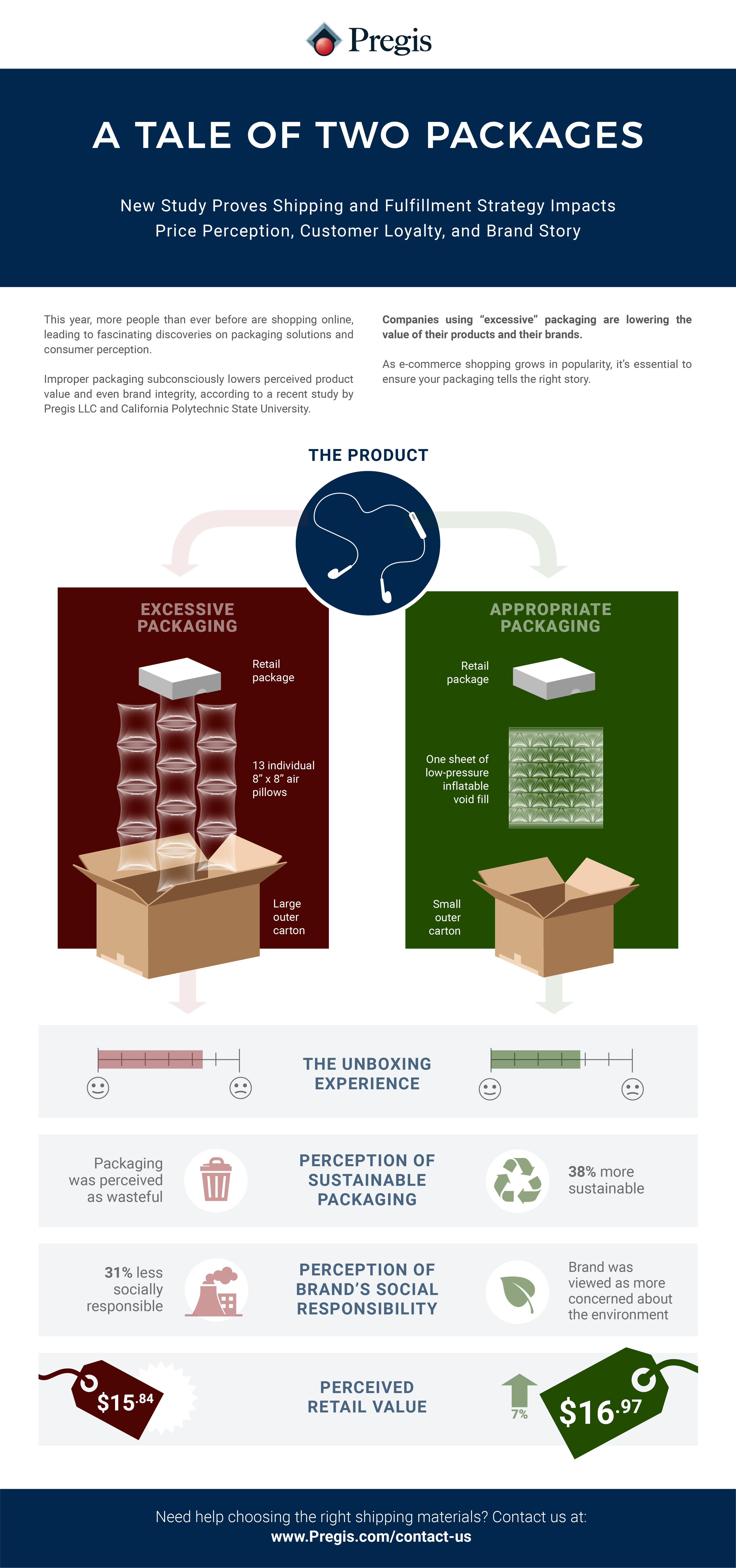New Study: Excessive Packaging Hurts a Company’s Bottom Line
Here is how shipping and fulfillment strategy can impact corporate social responsibility, product value, and brand loyalty.
People are shopping online at a rate never before seen. As of September 2020, e-commerce sales increased 43% year over year, now reaching $60.4 billion in revenue, according to Adobe Analytics.
As more people receive deliveries, consumers have become savvier with packaging solutions, developing a greater understanding of what makes an unboxing experience memorable. A curated unboxing experience is no longer a brand differentiator — it’s a must-have, according to BigCommerce.
Aesthetics and customer experience aside, a recent study by California Polytechnic State University, in partnership with Pregis LLC, determined that a negative unboxing experience, such as one with excessive packaging, might hurt a company’s bottom line in the long run, particularly among Gen Z consumers. Here’s what you need to know:
Unpacking Good (and Bad) Unboxing Experiences
For this study, Cal Polytechnic gathered 138 Gen Z participants in their late teens to early 20s, creating an even mix of males and females. Each one was asked to unbox a pair of Bluetooth® headphones in identical retail packaging (3.5 x 4.75 x 2 inches).
However, the participants — who were broken up into two groups — would confront different unboxing experiences, ultimately impacting their perceptions of the brand and merchandise.
Group A was given “appropriate” packaging, in which the Bluetooth® headphones box was packed into a small, 6 x 5 x 4-inch standard cardboard box, protected by one sheet of low-pressure inflatable void fill measuring about 15.15 x 6 inches. Group A participants opened a modest-sized shipping carton not much larger than the retail box inside, reaching the merchandise by unwrapping a reasonable amount of inflatable void fill.
Group B’s box included “excess” packaging. The cardboard shipping carton was much larger, measuring in at 14 x 10 x 6 inches. Inside, substantially more void fill was needed to hold the Bluetooth® headphones box in place, including 13 individual 8 x 8-inch air pillows.
After each person unboxed the headphones, they completed a survey to rate their experience, and the results were striking.
Excessive Packaging Is Disappointing
One of the first questions asked participants to rate packaging on a scale of one to seven. One indicated a very positive experience, and seven indicated a very negative experience.
Group B, with the “excessive” packaging, gave the experience an average rating of 5.20, compared to Group A’s 4.76. According to the study, the box with excessive packaging created an overall disappointing experience and was considered five percent less attractive than the box with appropriate packaging.
Even though the participants in each group did not know what the packaging was like for the other group, the participants in Group B with “excessive” packaging rated their experience lower on its merit.
Worse Sustainability Profile
Corporate social responsibility (CSR) is an increasingly important factor in purchasing decisions, especially within the last decade. Many people are concerned about climate change and waste, so some might not buy from a company that’s perceived as environmentally harmful.
Nielsen found that 66 percent of consumers surveyed worldwide are willing to pay more for goods from brands that demonstrated social commitment. Forrester Research found that “52 percent of U.S. consumers factor values into their purchase choices." About 87 percent of Americans will even purchase a product because its manufacturer advocated for an issue they cared about, according to a 2017 study by Cone Communications.
Our study with Cal Polytech found that the perception of social responsibility extends to the unboxing experience, too.
That brings us back to the study: Group A perceived the packaging to be “38 percent more sustainable” than Group B. This directly affected the participants’ perceptions of the company’s social responsibility. Those dealing with excessive packaging perceived the brand to be 31 percent less socially responsible.
Lower Perceived Product Value
One of the most surprising findings came when participants were surveyed about price perception of the Bluetooth® headphones. Group A believed the value of the merchandise was $16.97. However, for Group B, wading through the excessive cushioning and fishing out the merchandise from an oversized shipping carton lowered the perceived value to $15.84 — a seven percent difference.
Excessive packaging doesn’t just translate to a worse perception of CSR. It can actually lower the perceived value of products, pushing customers to purchase from competitors. This could translate to lower profits from lost sales, leading to an overall devaluing of a brand.
Investment in premium packaging, however, is a way to drastically increase the perceived value of both merchandise and the brand behind it. Another groundbreaking study we conducted with the University of Wisconsin found that premium packaging can increase perceived product value by up to 45 percent compared to economy packaging. Consumers also rated premium packages as 15 percent more likely to gift.

Need help avoiding excessive packaging or creating premium unboxing experiences?
Pregis IQ can design and validate custom solutions for your company

